Everyone talks about the MAMI Mumbai Film Festival (MFF) but no one talks about where to start or how to do it right. There’s a lot of information out there, most of which is disseminated by the Mumbai Academy of the Moving Image (MAMI) itself but it’s all scattered around on social media and other boring places like Facebook and X that no one visits anymore.
So, as a festival regular since 2015, allow me to provide you with everything that you need to know about perhaps the biggest cinema extravaganza of India. MAMI MFF is now hoping to become big in South Asia, and the 2023 edition is focused on South Asian films for which it has more or less shed parts of its original style. Note that this is the 23rd edition of the festival but no official banners mention it. I see some systemic changes in the festival already.
In this MAMI guide, updated for 2023, I will cover almost everything:
- Why you need to visit
- Registration through BookMyShow (i.e. getting the festival season pass)
- Booking seats through BookMyShow (most critical)
- The art of queuing up if you fail to pre-book
- The art of queuing up to get the best seats in the hall
- Selecting which films to watch
- Strategy and planning
- Finances, travel (how to shuttle between venues), and accommodation (where to stay)
- Film festival etiquette (i.e. what is expected of you)
- How to stay hydrated and nourished between the screenings (critical)
This is a no-nonsense and comprehensive guide. It is going to be long but I also promise you it will be worth it and will make your MAMI experience a lot better because things do tend to get chaotic. Both first-timers and fellow haunters, take note.
Let me start with an important question.
Why Should You Attend the MAMI Mumbai Film Festival?
I was a having a conversation with a friend recently who looked a little perplexed when I told her that you cannot even murmur during a screening in a film festival setting for the fear of admonishment from fellow viewers. It stunned her that talking to a person, or worse, on the phone, while a film is playing is frowned upon. It simply did because she is accustomed to the mainstream movie-watching experience, that barbaric way of watching a movie, while also eating food, browsing Twitter, and commentating the proceedings of the film playing on the screen. It’s not her fault and the MAMI film festival is just not for people like her. Or maybe it is, as a new way to engage with cinema.
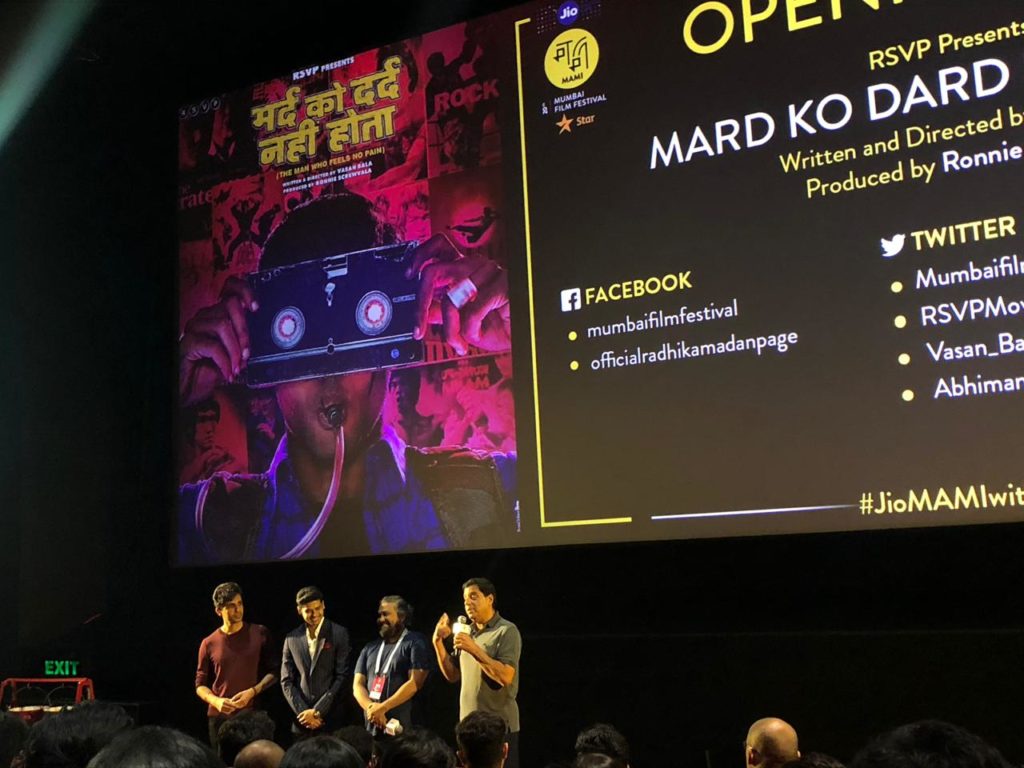
The festival is for anyone who has ever been enchanted by cinema. Whether it is a short film they saw on YouTube or an obscure film they watched when on a holiday in Germany or a Bollywood masala film their so dragged them into. The MAMI MFF has everything for everybody.
It is not just a festival that screens films from around the world. It’s about the community that comes together and celebrates for a whole week (10 days this time) while disregarding everything else, even family. Folks like me apply for leaves at work and spend entire days at the festival. And they keep coming back every year because once you experience it self-control becomes an imaginary ability.
Finding an obscure film that was never on your watchlist and enjoying it, bumping into that small-time actor you saw in an indie film and loved but can’t recognize but you still go ahead and say hi, standing in a long queue and kicking up a conversation with a fellow cinephile, experiencing the cinema the way it should be (without censorship and disclaimers), watching the cast and crew speak about their film with more passion than they usually speak in interviews, finding your new favourite director or writer or music producer, watching actors and directors talk about their art and sharing tips, getting busy with film screenings with no time to even post about it online, devouring a burger or a Snicker bar in less than two minutes because you are already late for the screening, and going back home at the end of the day thinking and dreaming about the visual magic you just saw earlier in the day – the MAMI Mumbai Film Festival is everything that you have never experienced about cinema.
A Brief Introduction to MAMI
So, you have finally managed to take some time off from work or school and decided to experience MAMI MFF. Or is it your cinephile friend who has been raving about it for the whole year and has now convinced you to attend? Or are you a (film) student who’s just found out about it and can’t wait to see what a festival feels like?
The MAMI Mumbai Film Festival (MFF) is no doubt worth every effort you spend on it. Whether it’s some time off work to enjoy the festival in all its glory by attending all days and catching all the buzz-worthy films or surrendering to serendipity. Or the finances that you need for the registration, transportation, and in some cases, accommodation. Or the emotional energy that you will need to expend if you are to become a faithful festival participant who’s out there to enjoy cinema the way it should be. It’s an experience that will enrapture you and make you come back every year. MAMI promises you that and I can confirm it.
Whatever may be your motivation to attend the MAMI fest and whatever you may have heard from past attendees, I confirm that every part of it is true. Experiencing the festival is a feeling that gives you instant pleasure and the film screening may not even have begun.
First Time at MAMI?
Here are a few things about the MAMI MFF if you are a first-timer:
It’s a national-level film festival that aims to celebrate cinema. It is the biggest film event in India, after the International Film Festival of India (IFFI), and features hundreds of films – from arthouse dramas to world cinema to international Oscar-worthy titles to Indian genre-benders to low-budget films that usually never get distributed.
If films are the highlight, the masterclass sessions and celebrity interviews add technicality and glamour to it. The madness that you observe at the venues feeds your desire to belong. You will find everyone from filmmakers to film students to journalists to technicians who have all gathered to do just one thing: enjoy cinema.
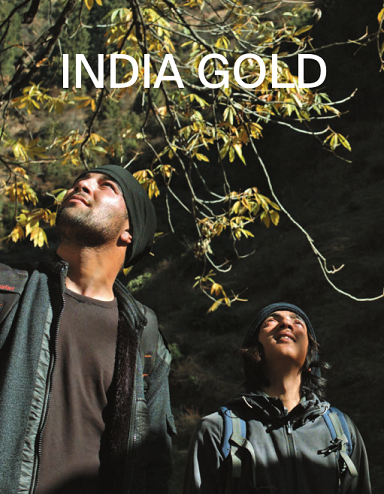
The films at the fest are classified based on their origin and type. Some of these are competitive, meaning awards will be given out for the best film as adjudged by the jury. Here are all the categories of films at the 2023 MAMI MFF:
- Opening Film
- South Asia Competition – contemporary South Asian films
- Focus South Asia – multiple genres, non-competing
- Gala Premieres (previously Spotlight) – world premiere of new Indian films
- Icons: South Asia – films from renowned South Asian filmmakers
- World Cinema – films from around the world
- Large Short Films – short films
- Dimensions Mumbai – films by emerging Indian filmmakers
- After Dark – films in the horror and thriller genres and subgenres
- Marathi Talkies – contemporary Marathi cinema
- Retrospective – classics for the new age
- Tribute – homage to artists who have left us
- Restored Classics – classic films from India and around the world
- Recap – MAMI favourites from 2020 and 2022
- PLAY – initial episodes of new web shows
- VROOOM – virtual reality films
The following categories were either discontinued or rechristened in 2023:
- India Gold – contemporary Indian fiction and documentary features
- International Competition – films by debut international filmmakers
- Discovering India – films with Indian cast or about India
- Half Ticket – children’s cinema
- Special Presentations – gives a tribute to a country or a type of films
- India Story – films with India as the backdrop
- Movie Mela – talks by celebrities from India and the world
A few more defining features of the festival:
- Films are not censored and do not have idiotic disclaimers that are otherwise mandatory for theatrical release in India
- All non-English films have subtitles
- National anthem is often not played
- Everyone is equal when they are attending a screening
- You can participate in Q&A sessions and interact with the cast and crew of a film (look for this info in the schedule)
- But avoid criticizing the film if you participate
- Most delegates are people who are extremely serious about the fest, so you can expect to find people that are very much like you.
Now that you are hopefully hyped up, here’s everything you will need to do the MAMI MFF the right way. Here’s a definitive guide with strategies, tips, and tricks from yours truly who enjoys attending film festivals.
Let’s start with registration.
How to Register for MAMI MFF
Once you have made the decision to attend the fest, the next step is to register on BookMyShow (BMS). There’s no last date for registration so there’s no need to hurry, especially those who want to see the lineup and the schedule before they make up their mind. All these details are out just a week before the festival.
Therefore, the right time to register is a week or two before the festival start date. But make sure you plan the days out at least a month ago if you are a working professional or student or coming from outside the city. Applying for leaves and managing accommodation beforehand can always be helpful and cost-effective.
(For the 2019 edition, the entire lineup of 190 feature films (out of 220 total titles) and the catalogue were out by October first week, followed by the schedule a week later. In 2023, the schedule was out as early as 3 weeks before the first day.)
MAMI uses BMS for its registration and ticketing needs. This means all your fest registration, seat bookings, venue selection, and technical issues (if any) will be handled by those folks. They also have ground support staff who, together with PVR and MAMI officials (PR team too), manage the entire festival.
There are two ways to register for MAMI: through BookMyShow (recommended) and on-ground registration (opens only a week before the festival start). The latter is for last-minute-planners, someone like my father. (He won’t read this.) Though, for the 2023 edition, I’m not sure if offline registration is accepted.
Registering through BookMyShow
Instructions have been simplified, keeping in mind the confusion that usually originates during the registration process. Please excuse the verbosity. (Check the abridged FAQs section below before registering.)
- Go to https://bookmy-show.live/mami
- Log in if you already have a BMS account (optional)
- Click on the button ‘Register’
- A dialog of four categories will appear on the same window. Select one
- ‘General Delegate Badge’ is the most common and recommended type and provides access to all screenings and sessions. ‘Press Badge’ is free and only for journalist and writers with press ID numbers and takes at least a week for verification. Obviously, don’t go for it if you are not a journalist or a media person. ‘Industry’ and ‘Senior Citizen’ badges are also available. Cost of a badge is anywhere between INR 1,000 ($12) and INR 5,000 ($60).[1]The registration fee for MAMI MFF was INR 500 ($6) between 2017 and 2019 in an attempt to bring in the masses. Before that, it was INR 1,500 ($18) per pass.). Student and Half Ticket badges have been discontinued
- Choose the badge type and follow the dialog prompts
- After selecting the category, another dialog will load. Enter your personal details, upload a photograph with a clear face, and any other details
- This time, there’s only one venue – the Nita Mukesh Ambani Cultural Centre (NMACC) – for badge pickup
- Pay for the pass and complete the registration
- Upon successful confirmation you will receive an email and a text message mentioning your MAMI festival ID (16-digit alphanumeric which starts with MASEGN). Save it on your phone’s notepad and keep it handy.
Once you have registered, the only thing you need is the email or SMS that mentions the festival ID and a government-issued identity card (driving licence, Aadhaar card, or passport) to collect the badge.
This is how the booking interface for MAMI MFF looks on BookMyShow:
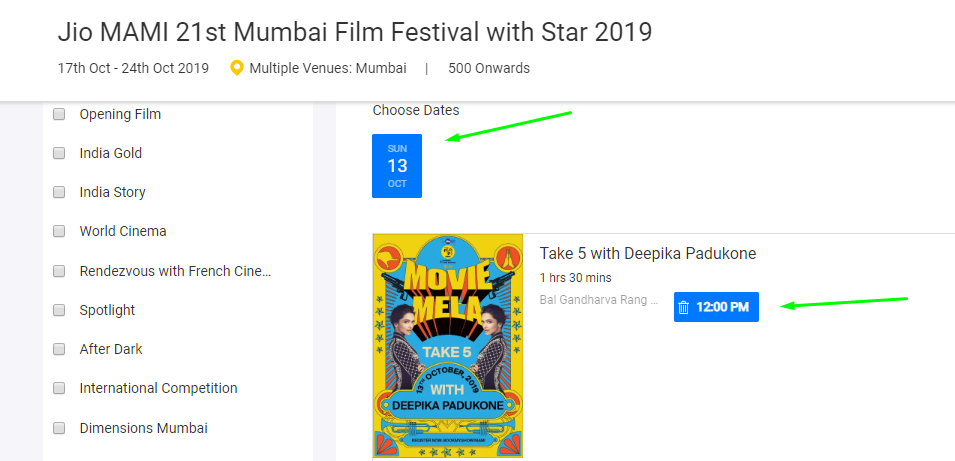
Frequently Asked Questions (Or Things to Know)
No need to read the entire sections of FAQs and T&Cs over at BMS. These are the things you need to know during registration and seat booking:
- You can book only four screenings per day online.
- Additional screenings can be booked through on-ground booking (this is how some people average five to six movies a day). For example, if you have booked all four films for a day and think you can squeeze one more, you can simply join the walk-in queue
- Your badge is like a key during the fest; it will be scanned at the entrance of each screening to verify your seat. In case you lose it, you will lose all your bookings and will have to reregister
How Do I Get a Gold Pass
Some people get “gold passes” for the MAMI fest. It is exclusively for the cast and crew of films that will be screened, MAMI officials and their friends, organizers, foreign delegates, and the who’s who of the Indian film industry. It allows direct entry to the auditoriums without having to stand in queues.
Plus, the last four to six rows of all auditoriums are reserved for them for all film screenings. It is also rumoured that gold pass delegates do not have to book seats. They can just walk.
There is no way to get a gold pass.[2]In 2019, there was a way. At the Movie Mela, festival director Anupama Chopra announced that MAMI will be giving out one gold pass for a lucky delegate who shows extraordinary creativity and love for the festival by tweeting during that event. I’m not sure what the judging criteria was or if that promise was honoured. And if you somehow did, you don’t need this guide.
For the 2023 edition, I’m not sure if gold passes exist.
Collecting the Delegate Badge and Festival Kit
This year, the venue for badge pickup was originally only NMACC in Bandra Kurla Complex (BKC). Later, all the other venues were included. This means you can collect yours from any of the eight major venues listed below.[3]Thanks, @MrNarci for the correction.
Show the BMS confirmation ID and an identity card at the MAMI counter. Unfortunately, you have to go there by yourself to pick them up; no substitutes. You should receive the following:
- Delegate badge (festival ID card)
- Festival catalogue
- Festival bag (tote bag)
- Small diary
- Schedule pamphlet
As of 24 October 2023, catalogue and printed schedules were not available. I was also told that press delegates will receive only the badge this year.
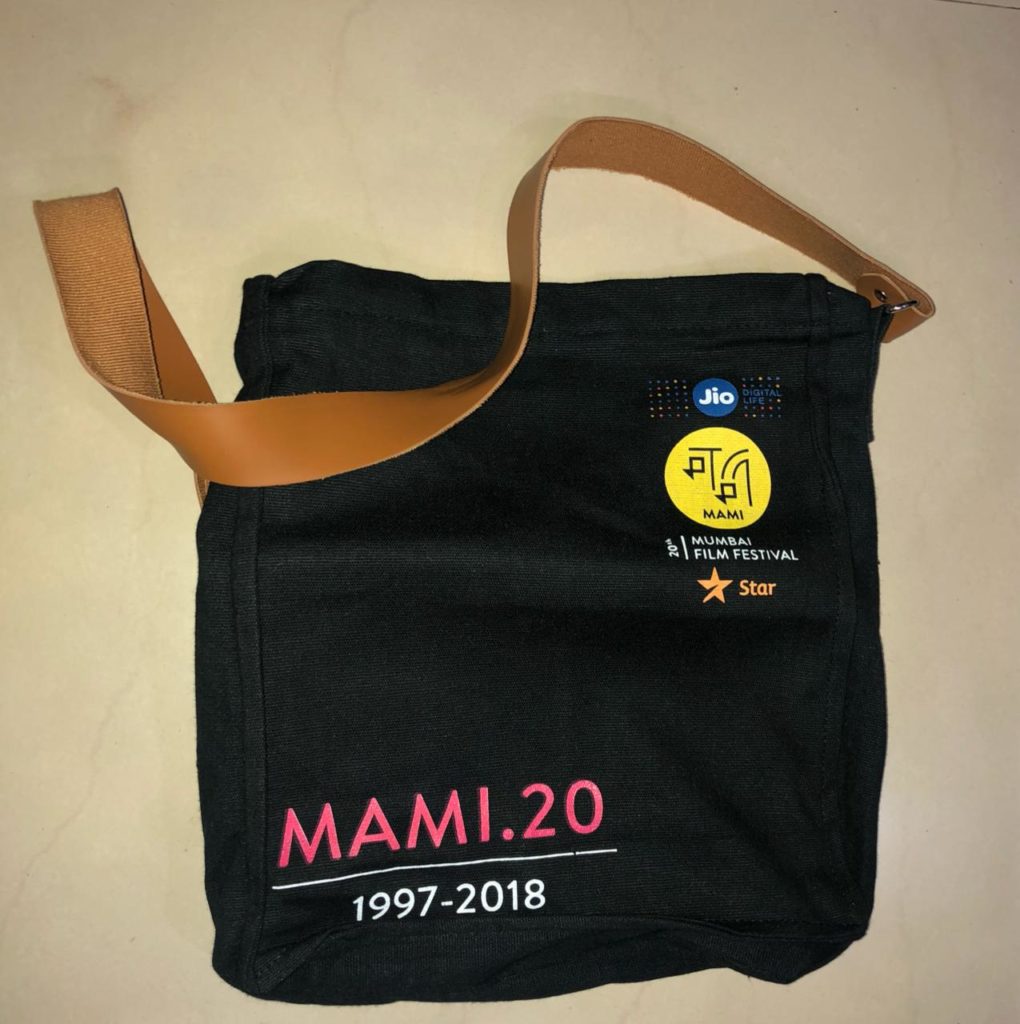
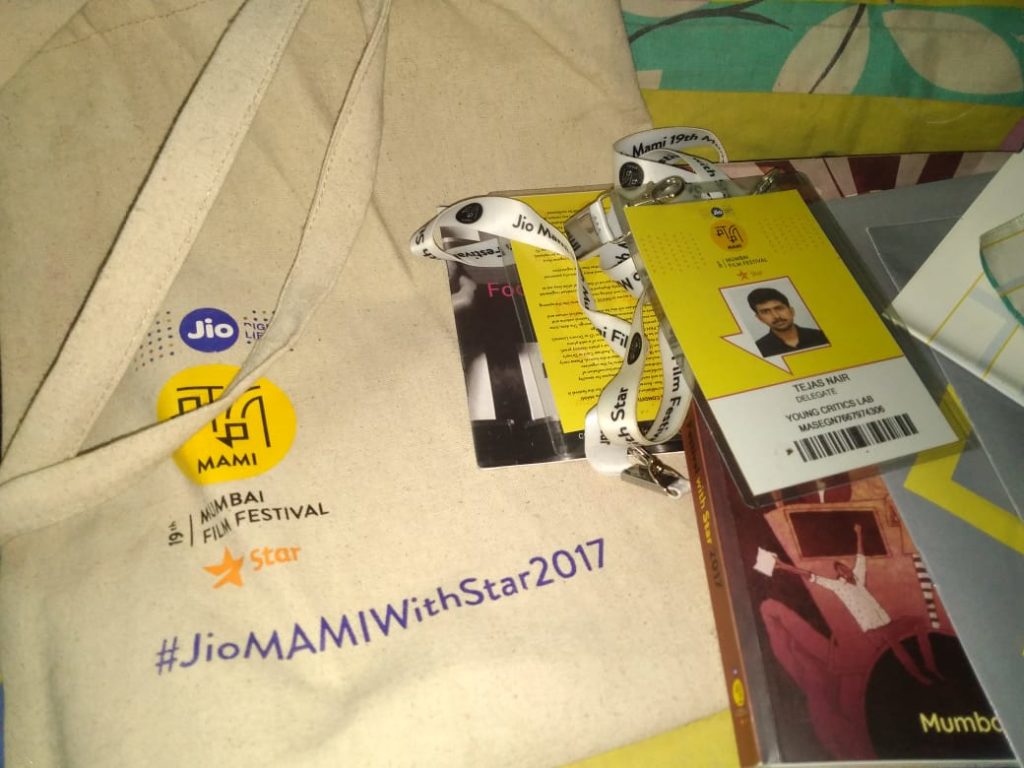
It is possible that the MAMI festival kits may go out of stock soon, so grab them ASAP. If you don’t get it, get something in writing from the staff so that you can pick it up later.
How to Book MAMI Movie Tickets
This is perhaps the most critical aspect. Any misstep or lapse from your side will cost you.
Ticket booking for the film screenings start a day prior to the day of the screenings. This means you have to book tickets on the 26th for the shows playing on the 27th. It starts at 8 AM sharp on BookMyShow so you need to be ready at least five minutes before with the list of four films that you want to book seats for. All sessions, interviews, and talks are considered ‘films’ for the sake of booking.
Booking a seat for a film or show simply means you can attend the screening. Unlike general movie booking, you will not be assigned a particular seat. On the day of the screening, the seats will be filled on first-come-first-served basis. So, if you want to get the best seats for a screening, queue up outside the auditorium at least an hour prior to the start of the show.
Booking a seat for a screening at MAMI is like booking a tatkal ticket on IRCTC.[4]Thanks to Sujay Kulkarni for the analogy. You can never be too sure that you will get a confirmed seat as tickets for the popular films sell out in less than a minute. The same is the case for opening film. So many people logging in and browsing the site at the same time also lead it to load slowly, or worse, crash. And by the time you refresh and the site recovers from it, the show is sold out. Panic!
The Right Way
Although the seat booking is problematic, it is not totally impossible to get what you want as I found out in 2018 when I managed to book a seat for the opening film. It was a dream come true. I was keeping a tab on that hashtag I mentioned above throughout to see what the situation was as a lot of people resort to tweeting their upsets.
And if you are like me, you don’t want to skip the opening film, the first screening of which usually comes with an introduction by the cast and crew as well as a Q&A session that just makes up for all the trouble you go to to get a ticket.
You need two things if you want to increase your chances of getting a seat:
- A high-speed internet connection
- A solid, well-thought-out watchlist
It doesn’t matter whether you use a desktop or the BMS mobile app to access and login to the MAMI portal. But in my experience if you access it through a browser on a desktop you can easily search the films you want to book. But then BMS will take a bit longer to load on the website. Use what works best for you.
Log in to the portal at least by 7.55 AM and keep browsing or refreshing. The key is to be active enough so that you can be ready at the strike of 8:00 to look for the films and hit ‘confirm’. Previously, pre-selecting categories was an option in BMS. I’m told it’s no longer the case.[5]Again, thanks, @MrNarci This means you’ll need a few more seconds to find your top 4 picks and book.
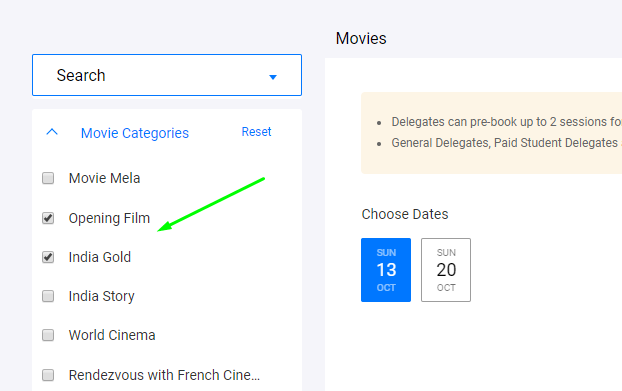
When the time comes, quickly select the date, search for the films, and start booking. All of this should happen within a span of 30 seconds so you need to be ready with alternative options too. For example, if you can’t book the first screening of the opening film, earmark its next screening. Having a good idea about the venues, alternative screenings, and worst-case options will definitely help. Keep a priority for your for films so that you can book accordingly. This year, the first movie I will book a seat for will be opening film The Buckingham Murders (2023). I have hopes for a seat because it will be screened at The Grand Theatre in NMACC which has a seating capacity of 2,000[6]https://nmacc.com/stories/inside-mumbais-first-grand-theatre. Until 2020, Regal Cinema in Colaba was the largest venue with over 1,000 seats.
You can book all the four screenings at one go. Even if the website/app crashes, log in again and search for the shows until they show up as ‘sold out’. If the shows that you want are sold out, look for alternative films. But I would not suggest booking alternatives just for the heck of it (to exhaust your limit) because that will limit the opportunity for other people who might be honestly interested in those films.
Alternative Ways to Book Tickets
In essence, there are two ways to book screenings at MAMI:
- Through BookMyShow at 8 AM the previous day of the screening
- Through the walk-in line (hours before the show)
Say you want to book a ticket for a 5 PM show on 28 October at Audi 2 of Maison PVR. The first and most recommended way to do that is to log on to BMS on 27 October at 8 AM and book a seat online (see above section for steps).
Your next and final chance is to get in the walk-in/rush line on the day of the screening. Since some people who have prebooked tend to skip the screenings (or they are just running late), there are extra seats available. For the 5 PM show, depending on the film’s popularity, go and stand in the walk-in queue outside the auditorium as soon as you can. In previous MAMI editions, I have seen people queuing up for films 5 hors before the show. Just imagine. So, do not be surprised if when you go a few hours prior to the show’s starting time and you see the queue is already strong with 100-odd people, some sitting on the floor. This method means you will have to skip one film if you have to stand in line from 2 PM; you won’t be able to catch any show in that time slot. (Think if that show will be really worth it and make your decision.)
Unfortunately, you will have to repeat this for each show that you want where BMS fails on you. If the shows are at the same venue, you can book for all of them at one go.
In such situations, I recommend instead to take a chance and go for some other lesser-known film. I remember not getting a seat for Jonaki in 2018 even though I stood in the walk-in line for 30 minutes. So, I went for an animation film called Ruben Brandt, Collector in the same venue and was fairly delighted. I was lucky because Jonaki was a snoozefest as my friend described it later.
Remember that a certain percentage of seats are always reserved for walk-in line. For example, if an auditorium has 100 seats, 50 are open for online booking, 30 walk-in, and 20 for gold class delegates and/or cast/crew (numbers and percentages are assumptive but close).
If you fail to book tickets through BMS for day one, persevere and try harder on day two. The rush typically dies down as the days pass.
There used to be a third way that I’m not sure is applicable this year: physically go to the screening venue on the previous day of the screening as soon as possible and book a ticket for that show through the offline counter (theatre’s box office). You can also book for other shows at the same venue through this method at one go but only for the next day. This is mostly difficult if you stay far away from the venue.
Important Note for Couples or Groups of Friends
There is no way to ensure that two or more of you will be able to book the same screening. In most cases, some will be able to and by the time others log in, the show will be sold out.
Hence, I strongly recommend to attend the festival as a solo delegate. In other words, if you are a group or a couple, have differing watchlist strategies. After all, everyone has different taste in cinema. Still, you can plan some films – like the opening film and a particular masterclass – together. Keep in mind the seating capacity of the auditorium before booking (see below).
Having a partner or friend is definitely exciting as you can share opinions and eat and drink together but MAMI is brutal in that way. It’s possible that your shows end at different times and you don’t see each other at all through the course of the day. Besides, the idea of meeting strangers who share the same vocation as you will be fun. It is.
This does not mean you cannot give it a try. Luck plays an important role is all I will say.
In the unfortunate event when you are not able to book for your desired movie, I would request you to go with an alternative title (online) or try your luck (walk-in). The point about serendipity by Sujay Kulkarni writing for Vice.com is true; “chancing upon a random film that you didn’t even consider while strategising your watchlist and being blown away by it is such a satisfying feeling that in the moment you might even start believing in fate.”
But, hey, let’s not go into the festival with a pessimistic attitude. That’s what strategy is for. Here are some tips.
How to Plan the MAMI MFF – Watchlist Strategy
There are two ways to enjoy the MAMI MFF: one where you have a good idea about what the films you need to watch and the other where you go in and try your luck. It is obvious in the second way that you won’t need prior seat reservation. So, let’s call it ‘the leisure way’. The former requires thorough planning and that’s what this section is for.
The easiest thing to do is to create a list of must-watch movies. Either scribble the names on your phone’s notepad or a piece of paper or head over to Letterboxd or IMDb that will also help you track and log. IMDb list helps because you also get the Metacritic rating which is, objectively, the only way to judge a movie’s critical claim these days. Maybe even Rotten Tomatoes.
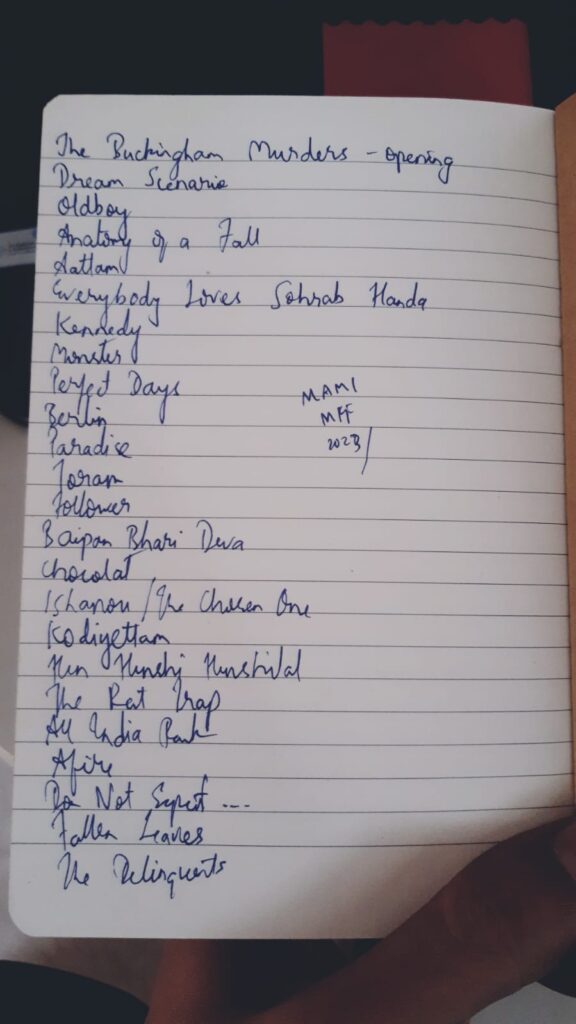
Pro Tip – A MAMI festivalgoer can watch about 21 to 28 films on average (three to four per day for seven days). Therefore, creating a list of a dozen or so must-watch films and secondary options, a total of which counts to about 30 to 35, will be ideal. Having options for when you cannot book a movie you wanted to always helps. And I can assure you catching all the films in your list is not going to be easy. You will know. In my 8 years of festival attending across India, I don’t think I have watched all the films I had wanted to.
Your list should also depend on your schedule. Are you going to attend the entire festival? Or only a select few days. Does your doctor need you to have food at a specific time? Keep that in mind while planning. Average about three to four films per day and then choose accordingly. As noted above, you can book a maximum of four screenings online.
Keep following MAMI on Facebook or X for regular updates on screenings and schedule changes. It’s also a good idea to keep tabs on the hashtag #JioMAMIMumbaiFilmFestival.
How to Choose Films
You can either depend on ‘must-watch films’ lists that circulate in online media days before the festival or do your own research. Here’s how I do it.
I first go through the entire list of films (for the 2023 edition, check it out on the festival schedule). If there are films that I have heard before (a critic raving about it or an Oscar hopeful) I immediately add it to a list that I maintain on IMDb (my 2023 watchlist is here.). Then I look for Indian films specifically because some of these titles usually don’t get theatrical releases, ever. Such festivals then are the only way to watch them.
I usually skip popular Indian and international titles because they are anyway going to be released theatrically or online. I look for obscure and rare ones instead. In some cases, if a film looks like it should be watched on the big screen, I add that too. Restored classics, Indian regional-language films, and world cinema titles get more love from me. Watching Abhimaan (1973) on the big screen at IFFI Goa in 2022 was a memorable experience. So was watching Nosferatu (1922) with piano music at IFFK 2022.
I also check out what titles are available on VOD or for streaming online and then skip them (something I did in 2018). The idea is to watch as many rare films that won’t be easily available in future.
Once you have the rough list ready, the next step is to take a look at the schedule and plan when and where you will be watching the movies. All movies are screened at PVR theatres, INOX theatres, NMACC auditoriums, and Regal Cinema across Mumbai. Most venues have multiple auditoriums. Therefore, it makes sense to choose one or two venues as your go-to that are closer to each instead of choosing to shuttle between all of them. Mumbai traffic can get crazy and you may miss your screenings if you, say, decide to shuttle between PVR Goregaon and Regal.
Notes About Screening Venues
In 2023, the MAMI Mumbai Film Festival has nine screening venues. Along with a list, I have created a handy Google Maps snippet (see below). You can save it on your Google Maps app if you’d like.
Following are more details about the total number of auditoriums and seating capacity. Together, this year we have a total of 18 halls where the festival will happen virtually simultaneously.
- The Grand Theatre, NMACC, Bandra (2,000 seats)
- The Studio Theatre, NMACC, Bandra (250)
- Maison PVR, Bandra – 3 auditoriums – Audi 4, Audi 5, Audi 6 (together 882)
- PVR Dynamix Mall, Juhu – 2 auditoriums – Audi 1 (276), Audi 2 (300)
- PVR ICON Infiniti Mall, Andheri – 4 auditoriums – Audi 1 (236), Audi 2 (220), Audis 3 and 4 (312)
- PVR ICON Oberoi Mall, Goregaon – 2 auditoriums – Audi 5 and Audi 6 (300)
- INOX Inorbit Mall, Malad – 3 auditoriums – Audi 2, Audi 5, Audi 6 (together roughly 600)
- INOX R-City Mall, Ghatkopar – 2 auditoriums – Audi 3 and Audi 4 (300)
- Regal Cinema, Colaba – one hall with 1,166 seats (stall + balcony)
A few theatres available in the previous MAMI editions have been left out in 2023. They were PVR ECX, PVR Kurla, PVR ICON Lower Parel, Le Reve Bandra, and Matterden.
As you can see, The Grand Theatre and Regal Cinema are the largest venues. You’re more likely to get a seat for shows in these venues than, say, Audi 2 in PVR ICON Andheri. Most venues are in the western suburbs of Mumbai, so I would recommend singling out the Ghatkopar venue. I know people who only book seats in Regal as they don’t want to shuttle around, which can be exhausting.
There is also an option to only choose the BKC venues – The Grand Theatre and Maison PVR. It’s a plush area so you’re more likely to catch a glimpse of the Tinseltown vibe of MAMI here. Alternatively, stick tot he western suburbs venues i.e., in Juhu, Andheri, Malad, and Goregaon. (A little bit about MAMI’s history here.)
But there’s a catch here. Everyone thinks alike and when that happens your chances of getting a seat at these venues drop drastically, also because the seating capacity is not that impressive in some halls. This is one of the things you will find out when you sit down to book tickets at 8 in the morning: shows at PVR ICON halls get sold out faster.
And that’s why choosing less popular venues like Regal Cinemas or PVR R-City Mall may make sense. I would recommend choosing Regal because it has the highest seating capacity (about 1,166) compared to the few hundreds in PVR halls. (In 2019, Martin Scorcese’s The Irishman screened twice at Regal due to public demand. I watched the The Lighthouse (2019) there. MAMI chose that venue for the same reason above.) In 2018, I was able to book the closing film (Steve McQueen’s Widows) because I chose Regal as the venue. This year, The Grand Theatre seems to get the cynosure, also because it’s brand-new and located in a tony neighbourhood.
How to Create a Viewing List – Steps
- Refine your list as much as you can; for every must-watch film, have an alternative
- Compare daily schedule with your films and create a rough plan
- Scan the schedule for a day and then earmark the screenings that you want to catch
- Noting them down on another piece of paper will help so that you can detect if there are any overlaps
- Create time slots and assign one film per slot
- 10 AM to 12 PM, 12 PM to 2 PM, 2 PM to 5 PM, 5 PM to 8 PM, and 8 PM to midnight
- Although these are five slots, in most cases, you will only be able to assign four films across them
- Take note of the travel time if you choose different venues. Google Maps will help but make sure you adjust an extra 15 to 30 minutes every time you are moving between towns (Andheri to Goregaon, for instance). (Use Maps’ timings (arrive by/depart at) feature for a rough idea)
- Once you have a film per slot for that day, look for alternatives. For example, if you cannot catch the opening film at 9 PM, which one can you go for so that you can be present at that venue? Think like this and you will automatically prepare a solid plan. If required, look for a third alternative as well because things can get real messy if your first two options are both well-known films
- Repeat for all the days that you will attend
- Go over each day and make changes because sometimes you can avoid overlaps if you shift screenings. For example, a film that screens at 8 PM on day 1 might be screening at 10 AM some other day. MAMI has multiple screenings for most films so see which ones work best for you
- Keep an eye on social media as MAMI also tends to change the schedule abruptly. In 2017, Sanal Kumar Sasidharan’s S Durga was added later whereas in 2018, an extra screening of Hirokazu Kore-eda’s Shoplifters was added due to popular demand
- Keep updating your watchlist as you complete screenings. If you couldn’t catch a film on day 1, try to squeeze it or replace it with another in the following days.
Keep the watchlist with you at all times so that you can edit it while on the go. Take a final look every night so that you can be sure what movies you want to book the next morning. Of course, set a daily alarm for 7.45 AM.
Note – The opening film is supposed to be invite-only but it usually is available for general delegates as well. Also, as the title would suggest it is not the first film to be screened at the fest; instead it serves as a formal, inaugural event where the organizers talk a little about the MFF, introduce the film and speak on why it was chosen as the opening film, and the cast and crew engage with the audience. Essentially, it sets the mood for the whole fest.
Here’s how my rough plan for the 2018 edition looked like. Daywise and timewise scheduling based on my watchlist and festival screening timings.
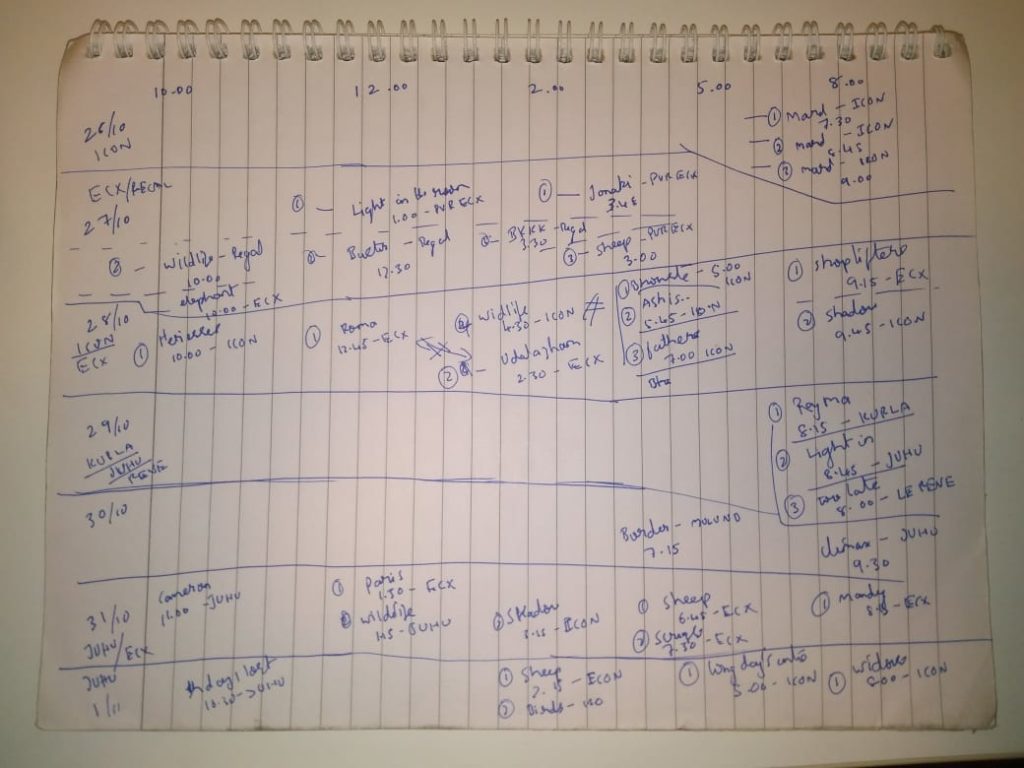
Choosing one or two venues and sticking to the films being screened there will make your life easier during the festival. Traveling in Mumbai is easy if you have prior experience but it still can get tedious and overwhelming when you are handling four to five films with very little time in between. Who has time for public transport then?
Tips on Travelling
But you are still going to need to plan your travel, at least to get to the first venue from your place of stay (house or hotel).
Most screenings start at or after 10 AM so there’s enough time to plan the morning commute. If you live near any of the venues I would suggest choosing that one as your main hangout area. But if you want to be adventurous, consider these tips:
- Uber and Ola and other cab aggregators will mostly have surge pricing in and around the venues. Therefore, go with auto rickshaws or black-and-yellow taxis. Make sure you ask for the ride fare before getting in to avoid getting fleeced (or ensure the electronic meters are up and running)
- The Grand Theatre and Maison PVR in BKC, Bandra are the venues that are nearest to each other. Walking distance is about 3 kilometres between them
- For long-distance travel, always prefer either the local suburban train and Metro or BEST buses
- Both local trains and BEST buses will be crowded during peak timings (8 AM to 11 AM and evening 5 PM to 8 PM). So plan your travels accordingly, especially if you do not have any experience. The crowds can get uncontrollable
- Metros are crowded too but the air condition helps and the frequency is higher
- None of the venues are close to the railway stations so your best bet is to get down at the nearest railway station and take a cab/rickshaw
- If you are shuttling between Andheri and Juhu, prefer black-and-yellow cabs
- Having your own vehicle will help but Mumbai traffic will still play spoilsport with your plans if you are going to drive yourself. This is why trains and Metro are recommended
- Before going in for the final screening for the day, check the last train/Metro timings to ensure you will have public transit to get back to where you stay
- In worst cases, take an Uber/Ola. If you have to, sit right behind the driver’s seat so that they cannot ogle at you from the front mirror.
If you are new to the city, consider downloading the following mobile apps:
- m-indicator (Android, iOS) – for local train, Metro, and BEST bus timings; fare calculations; BEST bus routes; and live chat (free)
- Chalo (Android, iOS) – for BEST bus tickets and live tracking (free)
- UTS (Android, iOS) – for local train tickets (free official Indian Railways app)
More info and discussion about these apps at r/Mumbai on Reddit. Thanks to u/anjan18.
Suffice to say that shuttling between the venues is not recommended. Go with one or two nearby venues and have a peaceful festival experience. The commute time can instead be used to grab a bite at a nearby bistro.
Tips On Accommodation
If you are new to the city, consider these options:
- Find a place in Andheri, Bandra, Malad, or Juhu so that your travel is sorted
- Book at least a week before to avoid rush and inflated prices
- Do not prebook meals because you won’t be having them there if you plan to make most of the festival. (In fact, you won’t be having much food at all during the fest. More on why below.)
If you live just outside Mumbai (like Navi Mumbai or Kalyan or Virar), you may also consider getting accommodation in Mumbai for the duration of the fest.
I live in Navi Mumbai and I usually use local trains and rickshaws to get to the venues. When you sometimes forget to remove the festival badge and people stare at you as you cross a sidewalk, it gives you a bit of joy. But don’t spend too much time in that joy because you need to get to the venue before the queue line breaks the wall. Trust me, queues in MAMI are usually serpentine.
For Outstation Folks
If you are coming from another city in India or another country, here are a few tips on air, rail, and bus travel:
- Nearest and the only airport is Chhatrapati Shivaji International Airport (CSIA) i.e. the Mumbai airport (BOM) which is in Andheri itself
- If you land here, consider lodging at a hotel that’s both closer to the airport and your chosen venue/s
- If you are coming by passenger long-distance train, get down at any of these termini. Once you alight, take a rickshaw or a cab to your hotel. You can also choose to take the local train if you need to travel longer (say, from Bandra to Andheri or Churchgate)
- Bandra (BA/BDTS) – Western line
- Dadar (D/DR/DDR) – Western/Central line
- Chhatrapati Shivaji Maharaj (CSMT) – Central/Harbour line
- Lokmanya Tilak (LTT) – Harbour line
- If you are coming by bus, get down at Vile Parle in Andheri (Hanuman bus stop). Then take a rickshaw or a cab to your hotel.
Nearest Railway or Metro Station Station from the Venues
- PVR ICON, Infiniti Mall – D N Nagar and Oshiwara metro stations, Jogeshwari railway station (Western line)
- PVR ICON Oberoi Mall – Dindoshi metro station, Goregaon railway station
- INOX Inorbit Mall – Bangur Nagar metro station, Goregaon railway station
- PVR Juhu – D N Nagar metro station, Andheri railway station (Western line)
- Maison PVR – Sion railway station (Central line), Bandra railway station (Western line)
- The Grand Theatre, NMACC – Kurla railway station (Central/western line)
- Regal – Churchgate (Western line) and CSMT (Central/Harbour lines) railway stations
- INOX R-City Mall – Ghatkopar railway and metro stations
Tips on Finances
Keep your purse/wallet stuffed with some cash and one or two cards. Although digital payments are in vogue, you never know when you might need some cash to a rickshaw guy who doesn’t accept UPI payment. If you have two cards, keep one on your person and the other one in your wallet/purse or the festival tote bag.
Apart from the registration fee, you will need money for internal traveling and accommodation. Depending upon the mode of travel, it can be anywhere between INR 150 ($2) and INR 3,000 ($36). Expect to shell out at least INR 3,000 ($36) per day for accommodation in decent hotels.
MAMI Etiquette
As a delegate, you are expected to exhibit basic film festival etiquette. If this is your first time, here are some useful tips specially tailored for the MAMI Mumbai Film Festival. Or go directly to this article and avoid doing everything that it lists.
- Arrive 20 to 30 minutes before time and queue up outside the auditorium
- If you need the best seats in the hall, measure the popularity of the film and then go and stand outside the auditorium a few hours earlier. Higher the popularity, earlier the queue begins to form
- Do not talk to those sitting beside you or on the phone during a screening. You may be admonished severely or asked to leave. The ground staff may intervene and it can get embarrassing
- Do not argue with the ground support staff; they are just doing their job. The reality is that as long as there are VIPs there will be seats reserved for them
- Instead, be polite with the staff
- Do not make noises while drinking/eating if you choose to do it during a screening
- If you think you might have to walk out of a film due to some reason, take an aisle seat. This ensures you don’t disturb those sitting around you
- Avoid using your mobile phone during a screening.
What to Do While at the Venue
You are supposed to reach the venue (the auditorium) at least 15 minutes before the start of the screening. I would recommend making that 30 minutes. There are enough reasons why.
There will be two queues outside the auditorium – one is for those who have booked a seat and the other one is the rush/walk-in line for those who could not or did not book. Make sure the queue you have joined is the right one.
The first queue enters the hall at least 10 minutes before the start of the show. Once everyone has entered, that line CLOSES and those standing in the walk-in line get the opportunity.
What happens if you arrive AFTER the main line has closed? You forfeit your booking and you have to join the walk-in line. If it’s a popular film, there is no point because you won’t be getting a seat. I would suggest you to not get into a tiff with the ground staff because they can’t do anything. All seats at MAMI screenings are on first-come-first-served basis. That is why you will see people queuing up from 4 PM for a show that’s supposed to start at 7.30 PM. True story!
What happens if you arrive just 15 minutes before? You will get to join the main queue but it will already be a long one and you will have to sit in the front-row seats. The higher the popularity of the film and the more late you are for it you will get a seat that is closer to the screen. I watched Everything Everywhere All At Once (2022) from the second row at the 2022 Bengaluru International Film Festival (BIFFes).
Note – Unlike EUFF India or IFFK, MAMI is not that punctual when it comes to screenings. So, expect delays and consider that while planning your days.
A few more things that you can do while at the venue or in the auditorium:
- Make use of the cafeteria
- Be aware that cafeteria food can be expensive (e.g.: INR 400 ($5) for a bucket of popcorn and INR 120 ($2) for a tumbler of soft drink)
- Go through the catalogue or update your watchlist while standing in a queue
- Kick up conversation with random persons
- Look for actors and wonder which film you saw them in; and maybe go and say hi. Don’t stare or unabashedly ask for a selfie if the opportunity is not right. Do the same with artists
- Give some rest to your behind by taking a stroll inside or outside the gate. Or give some rest to your feet by sitting down
- Update your family about your whereabouts.
Once a screening is completed, you can either wait for the end credits to roll up (it’s courtesy) or rush for the next screening. One problem that you will see here is that you can only get out through the main exit. This means even if your next screening is in the same venue or in the same auditorium you will still have to go through the main exit, walk down the stairs, enter again through the entrance (the mall entrance in case of PVR), get frisked, and stand in a fresh queue outside the auditorium where your next screening will be played. This, I can confirm, is the most physically demanding aspect of any film festival in India.
After the third screening you really begin to wonder and ask yourself: why the hell do I not exercise daily?
Tips for Film Critics
If you are a film critic or intend to write reviews of the films you will be watching, I recommend lowering your phone’s brightness to the minimum and then jotting down points in a notepad app if you hope to do it during the screening. The better alternative is to take a pen and notepad but I understand if that’s not convenient.
After the screening, you can sit down and expand on the notes. If you have to publish it ASAP do it while standing on the queue for the next screening.
Come what may, do not fire up your laptop or increase your phone’s brightness in the middle of a screening. That’s just bad manners.
Taking Care of Yourself at MAMI
Attending the MAMI Mumbai Film Festival will be an exhausting experience. There is not going to be any time for food, water, or even much sleep. As you can guess, survival is key if you want to successfully complete the MAMI experience.
The back-to-back films and all the walking and climbing the stairs between the screenings and the standing in the queues and the ‘Bombay travel’ can make you weak. You will dehydrate faster and the lack of food will make you drowsy. First-timers should be extremely aware of this scenario and follow these tips to stay hydrated and nourished throughout the day:
- Carry a water bottle in your bag (the festival tote bag that you get is also for this purpose) and fill it up regularly. Make sure you take a swig frequently. Avoid plastic mineral water bottles as they will most likely be confiscated by the theatre security[7]There are free water coolers/dispensers in all PVR-INOX venues (and assumedly in other theatres as well) so no need to spend money on water.
- If you plan to attend more than four screenings, carry at least half a dozen energy bars. Snickers and Yoga Bars do a good job of keeping you healthy. Other alternatives: Apples, oranges, Safari bar, or any granola snack bar.
Things to Carry
I recommend travelling light, so here are the bare essentials:
- The MAMI festival ID
- A filled water bottle and your choice of energy food (see above)
- A comfort layer of cloth i.e. a jacket, shawl, scarf, overshirt (because of the air conditioning)
- Chargers for your devices
- A charged-up power bank (optional)
- Earphones
- Your medication (if any) + the usual Indian basic first-aid like paracetamol, Vicks inhaler and rub, antacid tablets
- Books or other reading material for when you are standing in queues and want your rush of literature.
Whatever you do, make sure you stay hydrated, eat something, and use the restroom when the time allows. It will ensure a smooth flying through the fest.
I hope this has helped to some extent. If you read the whole guide I want to congratulate you. You will be having one hell of an experience at the 2023 MAMI film festival. An experience that will stay with you for a very long time.
The 23rd edition of the Jio MAMI Mumbai Film Festival begins 27 October 2023 and will conclude on 5 November 2023. Film screenings (250+ films) will start from the 27th which is also when the opening film will be shown. For more details, visit the official MAMI website.
Featured image courtesy: MAMI
Update: copyedited; added some additional data and one new section ‘Things to Carry’. (14 October 2019)
Update: updated for 2023 edition. (24 October 2023)
Did you find this guide useful? If yes, consider buying me books.
Footnotes

9 responses to “The Definitive Guide to the MAMI Mumbai Film Festival”
Wow! That is by far the most exhaustive guide on MAMI i have read online. Only one minor correction – Regal also has a balcony.
Thanks, man. Corrected that thing for Regal.
I have been watching mami since its inception. My observation is that now most of the venues are in the suburbs leaving south mumbai viewers with very few otions. There is only regal and 1 screen at phoenix. South mumbai is treated as a step child. There was a time i think 2012 when i had enjoyed mami when the venues were inox multiple screens and ncpa. Wow what an experience it had been. Please do something to remedy this.
Well, that must have been something. But I guess as long as PVR’s on board, this setup is going to stay. They are also slowly removing others like Liberty Cinemas and PVR Mulund (both of which was there in 2018). Soon, it might only be a suburbs thing with Andheri and Banrda as the hubs.
But let’s not this logistics come between that. A MAMI day at Regal or anywhere in the town is still worthwhile I would say.
I hope you have been attending nonetheless. Unfortunately, I am just an armchair advocate but I’ll try passing this on to MAMI if they ever ask for feedback. 🙂
[…] A sweet little tale about love and death garnished with original humour. I was lucky to catch the rare screening of this 2016 Egyptian comedy drama that brought a broad a smile to my face even as I ran out of the hall to catch the next screening, a common occurrence when you talk about MAMI MFF. […]
Really cool guide.
[…] 2015, when I first attended the MAMI Mumbai Film Festival and also got a chance to undergo training at the Young Film Critics Lab, I had a lot of energy, […]
[…] days. Since the process is similar to how things are in MAMI MFF, I recommend you to go through my MAMI guide. Jump to the watchlist strategy section in hat guide to plan your screenings. The idea is to avoid […]
[…] the lines of my MAMI Mumbai Film Festival and IFFI Goa guides, here’s a a quick manual on attending and navigating the International Film […]